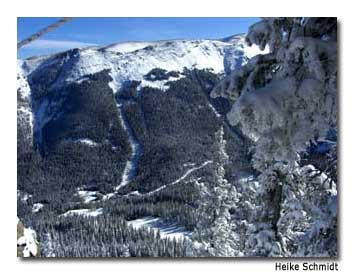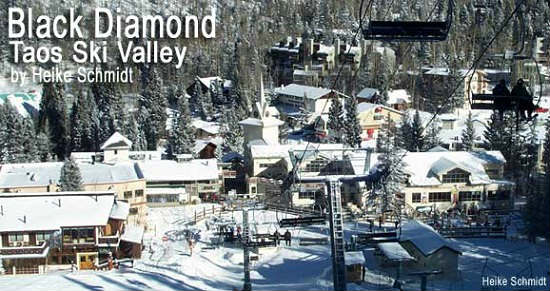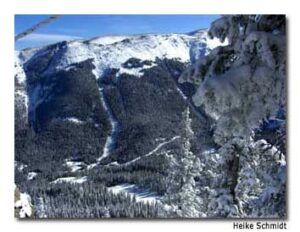

Antonio Zuni looks like a Native American straight out of a picture book: A ponytail of shiny black hair falls on broad shoulders. Copper skin, noble profile, proud look. The only thing not exactly fitting are flashy carving skis. Let’s be honest, who had not secretly expected a wild mustang instead? Antonio grins as if he could read thoughts.
The Pueblo Indian works as a ski instructor at Taos Ski Valley, a small winter sports resort in northern New Mexico. Granted, high on horseback, he would reliably sink into the knee-deep snow of Kachina Peak, which towers 12,480 feet (3804 m) on a high-desert plateau of burnt-red table mountains. Even the stubborn romantic in me must admit skis are much more appropriate in this alpine environment.
Here in this box canyon you don’t really feel like you’re deep in the American Southwest at first. The pointy tower of the base station, adorned with Middle Ages bric-a-brac like veiled damsels and bearded bards, seems much more apt for a little village in the Alps.
The small resort was in fact founded by German-Swiss Ernie Blake, who obviously must have been troubled by homesickness.
There’s a Hotel St. Bernard and Edelweiss here, and a restaurant called Rathskeller, and many of the buildings sport large wooden balconies with geraniums in flower boxes. The ski school’s children’s center is named “Kinderkäfig,” or children’s cage. The Blakes — Ernie died in 1989, but the resort remains a family business — have a strange sense of humor.
Father Blake scouted for the “perfect” ski area from the cockpit window of a Cessna. What he developed on these bold, jagged, arduous peaks is black-diamond and double-diamond runs (51 percent of the runs) and about a dozen dizzying chutes that are hair-raising by just looking up at them.
Taos is considered one of the most-demanding ski areas in North America. It was created by ski professionals for ski professionals — no fancy après ski ado, merely an athletic challenge. Perhaps that’s the reason why there are no snowboarders permitted in Taos, whom ski pioneers such as Blake probably never completely took seriously.

“Taos: A Four-Letter Word For Steep” is one of the official marketing slogans. “If you wish to relax, you’d better ski somewhere else,” declare some regulars boastfully. “Nonsense,” says Antonio, shaking his head vigorously and using his ski pole to point at a large yellow sign sitting at the foot of Al’s run, at first glimpse clearly a deterent for every beginner.
“Don’t Panic!” it reads in big, encouraging capital letters: “You’re looking at only 1/30 of Taos Ski Valley. We have many easy runs, too!” About a quarter, to be exact.
The first of today’s 12 ski lifts was built in 1956. A troop of Native American workers and a donkey named “Lightning” helped. They came from the ancient Pueblo de Taos, about 18 miles (29 km) down the curvy mountain road. The Native American village has been permanently inhabited for more than 1,000 years. UNESCO declared it a World Heritage site in 1992.
Today an estimated 150 people still live in the two multistoried residential buildings constructed from mighty timber beams and sun-dried bricks on both sides of the Red Willow Creek. Other than the lively stream, there is no running water, no electricity or plumbing on the reservation — a conscious decision of the elders to remain true to their cultural heritage.
However, tourism seems to be the most important source of income here. You may only enter upon paying a fee. Silver jewelry, pottery, drums, flutes and other souvenirs are sold in a few publicly accessible homes by flickering propane light.
The Spanish adopted the practical adobe style. The modern town of Taos, originally a colonial settlement dating back to the 17th century, is about a 10-minute drive south of Taos Ski Valley. It has developed into a pretty artist’s colony with many galleries and museums. Several times a day a shuttle bus leaves from the ski area for the historical Taos Plaza, the heart of town.
Taos has not always been an idyllic place, explains Antonio, as he tells of the Pueblo Revolt of 1680, a bloody rebellion against Spanish rule. As cultural director of Taos Ski Valley, he not only teaches proper snow-carving techniques, but explains the history of his people on guided mountain tours. Even though the tribal council only recently insisted that the ski resort’s old logo — a goofy Indian on skis with flying braids and loincloth — ought to be changed, old and new Taos inhabitants have long made peace with one another.
Antonio turns his face to the sky. The summits surrounding Taos are sacred to the Pueblo tribes. Not far from here, at Blue Lake, so they believe, they emerged from the underworld into the present dimension. “This happened in the middle of winter,” the young man continues. That’s why the cold season holds a great significance for his people. For Antonio personally, a trip down the slopes is a spiritual experience. “The mountain is alive,” the Native American says quietly. The icy wind feels like an embrace, and glistening snow crystals are winking.
“Ma qedveche,” Antonio intones in melodic Tiwa, his native language, as he concludes the tour, which translates to “may the creator keep you.” And like a blessing from above, thick white snow flakes start to fall on Taos.
If You Go
Taos Ski Valley
Pueblo de Taos
Taos Chamber of Commerce
www.taoschamber.com
- 6 Reasons to Visit Riga, Latvia Any Time of Year - April 18, 2024
- Travel Guide to Austria - April 17, 2024
- Travel Guide to Italy - April 17, 2024
